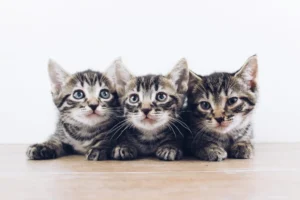Cats have a reputation for being jerks, ignoring their owners, scratching furniture, and causing all sorts of trouble. But why are cats such jerks? Let’s explore the reasons behind this common perception.
Feline Independence: Understanding the Nature of Cats
Cats have a reputation for being independent creatures, and this trait plays a significant role in their behavior that may come off as a bit jerky. Unlike dogs, who have been bred over generations to rely on humans for direction and companionship, cats have a more solitary nature rooted in their evolutionary history. They are descendants of solitary hunters, and this independence is deeply ingrained in their DNA.
When your cat ignores your calls or decides to knock things off the shelf just to see your reaction, it’s not because they are purposely trying to annoy you. It’s simply their way of asserting their independence and control over their environment. Understanding and respecting this aspect of their nature can help you see things from their perspective and improve your relationship with your feline companion.
Evolutionary Traits: Exploring Instincts Behind Cat Behavior
To truly understand why cats can sometimes act like jerks, we need to look back at their evolutionary traits. Cats are predators by nature, and their behavior is shaped by instincts that have been honed over thousands of years. From stalking prey to marking territory, many of the behaviors that seem jerky to us are actually essential for their survival in the wild.
One key trait that has persisted through evolution is the instinct to play rough. When your cat pounces on your feet or gives you a playful nip, they are simply acting out behaviors that would help them hunt in the wild. While it may seem like they are being aggressive, it’s just their way of exercising their natural instincts in a domestic setting.
Understanding these evolutionary traits can help you better appreciate your cat’s behavior and find ways to redirect their instincts in a more positive direction. By providing plenty of enrichment opportunities and outlets for their natural behaviors, you can help your cat channel their inner predator in a way that is both fulfilling for them and harmonious for your household.
Social Behavior: How Cats Interact with Humans and Other Animals
Cats may sometimes come off as jerks, but their behavior is often rooted in their social interactions. Cats are independent creatures, and they may exhibit behaviors that seem aloof or standoffish. However, these behaviors are typically their way of setting boundaries and asserting their independence. While cats may not always seek out human interaction, they can form strong bonds with their owners and show affection in their own unique ways.
When it comes to interacting with other animals, cats can be territorial and may display aggressive behavior towards unfamiliar animals. This is often a way for cats to protect their territory and assert dominance. Understanding these social dynamics can help you better navigate your cat’s behavior and create a harmonious living environment for all pets in the household.
Unique Insight: Keeping a peaceful and stress-free environment at home can help reduce negative behaviors in cats. Providing plenty of enrichment, such as interactive toys, scratching posts, and vertical spaces, can help fulfill their natural instincts and prevent them from acting out.
Communication Styles: Decoding Cat Signals and Cues
Deciphering cat behavior often comes down to understanding how they communicate. Cats use a combination of body language, vocalizations, and other cues to express their needs and emotions. For example, a flicking tail may indicate agitation, while purring can signal contentment. Learning to decode these signals can help you better understand your cat’s behavior and build a stronger bond with them.
Communication Styles: 1. Tail Position: A raised tail signifies a happy and confident cat, while a tucked tail may indicate fear or submission. 2. Purring: Contrary to popular belief, cats can purr both when they are content and when they are anxious or in pain. It’s essential to consider the context in which your cat is purring to understand their emotional state. 3. Ears: Forward-facing ears signal a friendly and curious cat, while flattened ears may indicate aggression or unease. 4. Hissing: Hissing is a clear sign of aggression or fear in cats, and it’s essential to give them space when they exhibit this behavior. 5. Eye Contact: Direct eye contact from a cat can be a sign of trust and affection, while dilated pupils may indicate excitement or fear.
Understanding these communication styles can help you navigate your cat’s behavior more effectively and strengthen your bond with them.
Playful Aggression: Unpacking the Playful Side of Cats
Cats being jerks? Not exactly! One key aspect to understand is their playful aggression. When your furry friend pounces on your hand or nibbles during playtime, it’s usually their way of mimicking hunting behaviors. Cats, as natural hunters, may display this rough play as a form of bonding or practicing their skills. So, next time you feel a sharp nip, remember, it’s all in good fun!
But here’s the catch: what we see as playful behavior can sometimes escalate, making cats appear more like jerks. If those gentle nips turn into painful bites or aggressive swipes, it might be a sign to reassess playtime. Providing appropriate toys, like feather wands or laser pointers, can redirect this energy into more acceptable outlets. Remember, a tired cat is a happy cat!
And here’s a pro-tip: always avoid using your hands or feet as toys to prevent encouraging unwanted behaviors. Keep play sessions engaging and interactive to foster a healthy bond without crossing into jerk territory.
Environmental Factors: How Surroundings Impact Cat Behavior
Ever noticed your cat’s jerk-like tendencies escalate during certain times? Environmental factors play a huge role in shaping feline behavior. When cats feel stressed, bored, or under-stimulated, they may exhibit behavior that comes off as jerky. Imagine feeling cooped up in a room with nothing to do – you’d act out too, right?
To curb these less-than-ideal behaviors, ensure your cat has ample opportunities for mental and physical stimulation. Introduce scratching posts, puzzle feeders, or window perches to keep them engaged and entertained. Creating a stimulating environment not only prevents boredom but also reduces stress levels, leading to a more content and well-behaved kitty.
And here’s a quick checklist to improve your cat’s surroundings and minimize jerk-like behaviors: – Provide ample hiding spots: Cats love having cozy hiding spots to feel safe and secure. – Offer vertical spaces: Cats are natural climbers, so vertical spaces like cat trees or shelves can satisfy their instincts. – Interactive playtime: Engage in interactive play sessions to keep your cat mentally stimulated and physically active. – Quality time together: Spend quality time bonding with your cat to strengthen your relationship and understand their needs better.
Remember, by addressing environmental factors, you can create a harmonious living space for you and your feline companion, turning those jerk moments into loving cuddles in no time!
Training and Enrichment: Strategies to Improve Cat Behavior
Cats can sometimes exhibit less-than-desirable behavior, but with the right training and enrichment techniques, you can help modify their actions for a smoother relationship.
1. Positive Reinforcement : When your cat displays good behavior, such as using their scratching post instead of furniture, reward them with treats or playtime to reinforce this behavior.
2. Environmental Enrichment : Keep your cat mentally stimulated by providing toys, scratching posts, perches, and interactive feeders to prevent boredom and decrease the likelihood of destructive behavior.
3. Consistency : Cats thrive on routine, so establish consistent feeding times, play sessions, and litter box cleaning to create a sense of predictability and security for your cat.
4. Redirecting Behavior : If your cat is exhibiting unwanted behavior, such as scratching furniture, redirect their attention to a more appropriate outlet, like a scratching post.
By implementing these training and enrichment strategies, you can help shape your cat’s behavior towards a more positive and harmonious relationship.
Love and Affection: Understanding the Softer Side of Cats
Behind their sometimes aloof exterior, cats have a loving and affectionate side that can deepen the bond between you and your feline friend.
Cats often show their affection through gentle head-butting, purring, kneading, and rubbing against you. These gestures signify their attachment and love for their human companions.
Additionally, spending quality time with your cat, providing cuddles, and engaging in interactive play can further strengthen the bond and show your cat that they are valued members of your family.
Embracing the loving and affectionate side of cats can help you appreciate their unique personalities and deepen your connection with these fascinating creatures.
Fun Facts About Cats: Surprising Tidbits About Our Feline Friends
Cats may seem like jerks at times, but there are some interesting facts that shed light on their behaviors:
Feline independence: Cats are known for their independence, which can sometimes come across as aloof or standoffish. They like to do things on their terms, which can lead to them seeming like jerks when they ignore your commands or requests.
Playful nature: Despite their sometimes grumpy demeanor, cats are actually very playful creatures. They engage in playful behaviors like batting at toys or pouncing on imaginary prey, but can quickly switch to ignoring you if they’re not in the mood.
Natural hunters: Cats have inherited instincts that drive them to hunt, even if they have a full bowl of food at home. This can lead to behaviors like knocking objects off shelves or bringing you “gifts” like dead rodents, which may seem like they’re being jerks, but they’re simply following their natural instincts.
Distinct personalities: Just like humans, cats have unique personalities. Some may be social and affectionate, while others may be more reserved or even grumpy. Understanding your cat’s personality can help you better navigate their sometimes “jerk” behaviors.
So, next time your cat does something that seems like a jerk move, remember these fun facts and try to see things from their perspective. After all, they’re just being their true feline selves!
Alex, a passionate animal lover, has experience in training and understanding animal behavior. As a proud pet parent to two dogs and three cats, he founded AnimalReport.net to share insights from animal experts and expand his knowledge of the animal kingdom.









